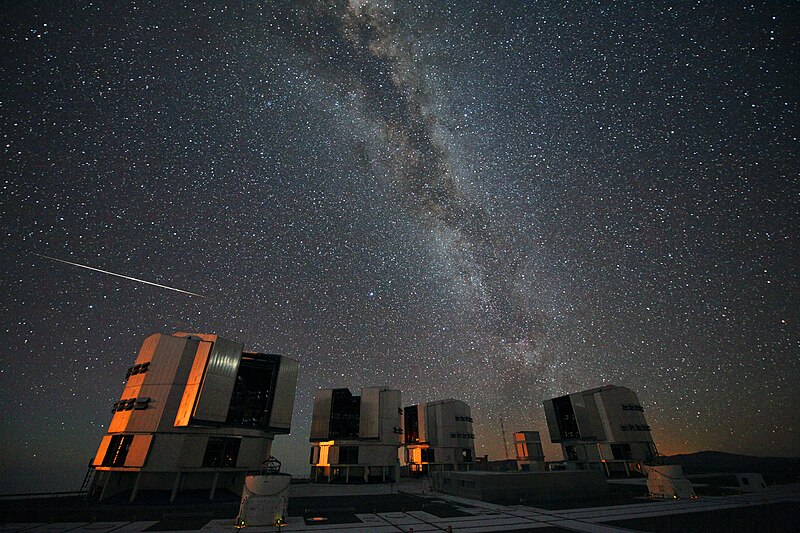Datoteka:The 2010 Perseids over the VLT.jpg

Veličina ovog prikaza: 800 × 533 piksela. Ostale razlučivosti: 320 × 213 piksela | 640 × 427 piksela | 1.024 × 683 piksela | 1.280 × 853 piksela | 2.560 × 1.707 piksela | 5.616 × 3.744 piksela.
Vidi sliku u punoj veličini (5.616 × 3.744 piksela, veličina datoteke: 5,68 MB, MIME tip: image/jpeg)
Povijest datoteke
Kliknite na datum/vrijeme kako biste vidjeli datoteku kakva je tada bila.
| Datum/Vrijeme | Minijatura | Dimenzije | Suradnik | Komentar | |
|---|---|---|---|---|---|
| sadašnja | 19:32, 19. veljače 2024. |  | 5.616 × 3.744 (5,68 MB) | C messier | full size |
| 11:34, 18. kolovoza 2010. |  | 4.000 × 2.667 (5,82 MB) | Lars Lindberg Christensen | {{Information |Description={{en|1=Every year in mid-August the Perseid meteor shower has its peak. Meteors, colloquially known as “shooting stars”, are caused by pieces of cosmic debris entering Earth’s atmosphere at high velocity, leaving a trail o |
Uporaba datoteke
Na ovu sliku vode poveznice sa sljedećih stranica:
Globalna uporaba datoteke
Sljedeći wikiji rabe ovu datoteku:
- Uporaba na af.wikipedia.org
- Uporaba na ar.wikipedia.org
- Uporaba na en.wikipedia.org
- Uporaba na eo.wikipedia.org
- Uporaba na es.wikipedia.org
- Uporaba na fa.wikipedia.org
- Uporaba na gl.wikipedia.org
- Uporaba na he.wikipedia.org
- Uporaba na hu.wikipedia.org
- Uporaba na it.wikipedia.org
- Uporaba na la.wikipedia.org
- Uporaba na mk.wikipedia.org
- Uporaba na ml.wikipedia.org
- Uporaba na ms.wikipedia.org
- Uporaba na my.wikipedia.org
- Uporaba na nn.wikipedia.org
- Uporaba na pl.wikipedia.org
- Perseidy
- Portal:Astronomia/Artykuł miesiąca 08 2012
- Portal:Astronomia/Artykuł miesiąca 08 2013
- Portal:Astronomia/Artykuł miesiąca 08 2014
- Portal:Astronomia/Artykuł miesiąca 08 2015
- Portal:Astronomia/Artykuł miesiąca 08 2016
- Portal:Astronomia/Artykuł miesiąca 08 2017
- Portal:Astronomia/Artykuł miesiąca 08 2018
- Portal:Astronomia/Artykuł miesiąca 08 2019
- Portal:Astronomia/Artykuł miesiąca 08 2020
- Portal:Astronomia/Artykuł miesiąca 08 2021
- Portal:Astronomia/Artykuł miesiąca 08 2022
- Uporaba na ro.wikipedia.org
- Uporaba na sh.wikipedia.org
- Uporaba na sk.wikipedia.org
- Uporaba na sl.wikipedia.org
- Uporaba na sv.wikipedia.org
- Uporaba na tr.wikipedia.org
- Uporaba na vi.wikipedia.org
- Uporaba na www.wikidata.org
- Uporaba na zh.wikipedia.org

